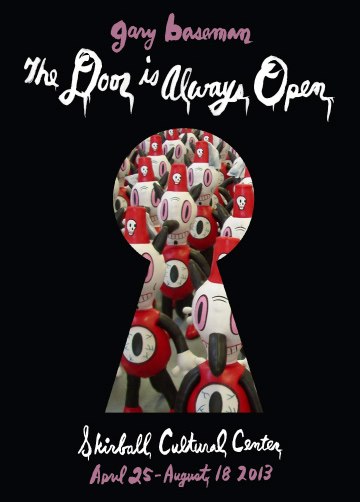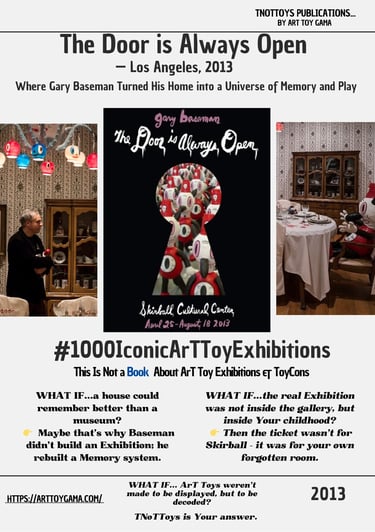We didn’t lose our inner child. We turned it into ArT Toys and More...with purpose.
The Door is Always Open — Los Angeles, 2013
Where Gary Baseman Turned His Home into a Universe of Memory and Play. The Door is Always Open in Skirball Cultural Center #00021 — TNoTToys Publications
TNOTTOYS PUBLICATIONS1000 ICONIC ART TOY EXHIBITIONS
Sergio Pampliega Campo & Cristina A. del Chicca
🌀 This post is part of an ongoing research series from Art Toy Gama’s editorial division:
📚 This Is Not a Book About Art Toy Exhibitions & ToyCons
Context Matters
Los Angeles, 2013.
The Skirball Cultural Center opens its doors …or rather, Baseman’s door.
For the first time, an institution of cultural gravity — historical, Jewish-American, deeply rooted in identity — allowed an ArT Toy creator to dismantle its walls and replace them with a house.
A home rebuilt from memory, loss, and vinyl.
Nothing about The Door is Always Open resembled a museum show. It wasn’t a retrospective. It was an exorcism designed as an invitation.
Baseman didn’t curate artworks; he unfolded his psyche.
Visitors didn’t walk through rooms; they trespassed.
This was not a celebration of the domestic; it was the exposure of it.
Here, Baseman didn’t just open a Show: he opened his house, his heart, and his subconscious.
It was a domestic mythology built from real walls, family photos, and the ghosts of childhood. Every object had a Memory. Every ArT Toy had a secret.
This first chapter of the trilogy was the origin point: the house before it became a passport, before it travelled through Taipei and Shanghai.
Los Angeles was the source code. The seed. The original wound.
POSTER Reading: The Keyhole as Weapon
A black background — almost velvet in its emptiness — gives shape to a keyhole.
But the keyhole doesn’t invite You to peek.
It stares back.
Through that narrow slit, we don’t see Art; we see an army of Tobys.
Red and white, with skull-like smiles and unblinking eyes, cloned yet alive.
The creature Toby is no longer a character. He’s a trigger.
Multiplied into a ritualized swarm, he becomes what the subconscious knows too well: trauma repeating itself until it becomes culture.
The keyhole is not metaphor; it’s exposure.
It’s the violation of privacy turned into visual architecture.
A psychological mechanism designed not to be read, but to be felt.
🔑 Symbolic Core
Why a keyhole?
Because a keyhole is the perfect paradox: it hides and reveals. It protects and provokes.
Privacy: The border between inner and outer.
Mystery: Partial access. You see just enough to want more.
Domestic intimacy: The household itself; Baseman’s chosen battlefield of the self.
But here’s the paradox:
The Exhibition claims “The Door is Always Open.”
So why show a lock?
Because it isn’t closed.
It’s open; not as passage, but as wound.
This is Not an invitation to visit; it’s an invitation to violate.
The black backdrop doesn’t frame; it devours.
Neuroaesthetically, the image activates the brain’s approach-avoidance system:
black provokes fear; the white hole promises reward. Curiosity overrides caution.
Baseman turns voyeurism into empathy.
You don’t see into his world. You fall into it.
🧠 What We See Through the Keyhole
Inside: a sea of Tobys.
Not decorative, but declarative.
This isn’t the individuality of high sculpture; it’s the collective force of the archetype.
Repetition becomes ritual.
The army of Tobys — identical yet haunted — speaks the visual grammar of the ArT Toy: reproducible, emotional, serial, pop.
Each Toby is a fragment of memory. Together, they’re a choir of recollection.
They don’t smile; they remember.
Their eyes, round and unrelenting, look back at the viewer.
The ArT Toy stops being an object; it becomes the observer.
Baseman is asking:
“Are You looking at my world, or am I showing You Yours?”
They are not soldiers of war; they are soldiers of Memory.
Still, alert, familiar.
And when You peek, You realize:
You’re not watching them; they’ve been watching You all along.
✍️ Typography as Emotional Pulse
The text doesn’t decorate. It trembles.
“The Door is Always Open” is not written; it’s confessed.
Handwritten, unstable, dripping, the typography itself is a nervous system.
It’s not a font; it’s a pulse.
Each curve looks unstable, as if remembering something it wants to forget.
Childlike, but not innocent.
It’s the handwriting of a child who knows too much.
The letters wander, defying typographic logic, following emotional gravity instead.
The title doesn’t shout. It whispers: “Come in, if You dare.”
An invitation disguised as a warning ; the visual trace of vulnerability made public.
🌍 Language as Emotional Access
English dominates the POSTER : simple, direct, untranslatable.
In this first chapter, “The Door is Always Open” speaks to everyone, no matter their tongue.
Later, in Taipei and Shanghai, English would merge with Chinese, expanding the invitation into dialogue.
Here, language isn’t national; it’s emotional.
🎨 Color as Emotional Body
Black. Red. White ; the neuroesthetic trinity.
Black absorbs: absence, void, Memory before form.
Red activates: pulse, blood, plastic life.
White freezes: the cut, the silence, the boundary.
The pink of “Baseman” isn’t sweet; it’s acidic.
A wound dressed as candy.
These aren’t colors of joy but of Memory; birthday balloons mixed with scraped knees.
Every hue acts as muscle memory, childhood recollection disguised as design.
This isn’t palette as decoration; it’s palette as confession.
🌀 Design as Emotional Gravity
Nothing in the composition is static. Everything orbits the keyhole.
The keyhole doesn’t sit in the center; it pulls everything toward it.
Typography, color, form… all drawn into that gravitational void.
This isn’t laYout. It’s attraction.
Design here is architecture of emotion, not geometry of aesthetics.
The POSTER doesn’t communicate. It confesses.
It doesn’t invite. It disarms.
Design trembling at the edge of meaning… where marketing dissolves into Memory.
What the Exhibition Showed: Home as Installation, ArT Toy as Totem
Inside the Skirball, there was no museum.
There was a house; but not one You could own.
Room by room, Baseman rebuilt his inner architecture:
the kitchen, the living room, the bedroom, the studio… each corner curated with painful intimacy.
Vintage toys. Family photographs. Jewish ritual objects. Paintings bleeding into furniture.
ArT Toys scattered like ghosts on a nightstand — Toby, Hot Cha Cha Cha, ChouChou — each figure a talisman of something lost.
Visitors didn’t walk through an Exhibition; they walked through a memory system.
Baseman didn’t display; he performed vulnerability.
Every corner recreated his childhood living room; a physical archive of his mythology of intimacy.
The ArT Toy wasn’t locked behind glass; it sat beside You on a couch.
The Show eliminated the museum pedestal. It replaced distance with discomfort.
Domestic surrealism, a soft demolition of the white cube.
A place where grief smiled and trauma came in vinyl.
Why It Mattered: The Emotional Legitimization of the ArT Toy
This wasn’t a Show about collectibles.
It was a Manifesto about Intimacy.
Baseman redefined what an ArT Toy could be: not a design object, but a sacred device of emotional recall: a pop-surrealist séance conducted through plastic and memory.
In an Art scene obsessed with irony and spectacle, he brought vulnerability back into Play.
He used ArT Toys not as products, but as witnesses of the self.
He showed that the domestic could be radical, and that Memory could be curated like a playground.
While figures like KAWS stormed markets and Kidrobot fueled hype, Baseman entered the museum through vulnerability, not prestige.
He didn’t ask for validation; he forced empathy.
Skirball declared silently:
The ArT Toy is as valid a vessel of truth as a Rembrandt.
This Exhibition mattered because it wasn’t selling ArT Toys: it was exposing wounds.
Because it said: “ArT Toys are not characters. They are family.”
And because it whispered the ArT Toy Gama credo before it was written:
Dis(Play) is the New Memory.
About the Gallery / Biography in Brief
Gary Baseman, born in Los Angeles, walks the line between illustration, pop surrealism, and emotional anthropology.
The Skirball Cultural Center, known for preserving Jewish heritage, embraced his universe as an extension of cultural memory; a bridge between tradition and imagination.
By letting Baseman turn its halls into his childhood home, Skirball dissolved the frontier between institution and intimacy.
It wasn’t curatorial courage, it was curatorial surrender.
The ArT Toy didn’t sneak into the museum.
It kicked the door down.
Here, Identity and Play merged into a single Act of Storytelling.
Legacy & Mutation
This Exhibition was not spectacle; it was Dis(Play): the Act of unfolding a wound and giving it shape.
The keyhole POSTER became a totem : a collectible that doubled as confession.
An object reminding the viewer that behind every ArT Toy lies a truth, not manufactured but remembered.
Baseman’s Toby became the emblem of a new language:
From object to subject.
From product to psyche.
From collection to connection.
What began in Los Angeles as personal confession became a blueprint for the ArT Toy Movement:
Art as vulnerability.
Design as Memory.
Plastic as ritual.
Los Angeles planted the seed: The Door is Always Open as personal mythology.
Taipei would translate it culturally.
Shanghai would globalize it.
This first version revealed the raw wound: the child behind the icon.
It established the axis of the trilogy: Memory as Rebellion, Play as ritual, home as museum.
Every later adaptation would orbit this … but Los Angeles remains the heartbeat, the original confession disguised as Exhibition.
Final Thought: ArT Toy Gama Perspective: Dis(Play) in Full Execution
This POSTER is not a promotional object.
It is the Exhibition; compressed, encrypted, distributed.
It operates through three coordinates:
The Absurd: A hundred Tobys, identical yet unsettling.
The Emotional: Color, contrast, repetition …all triggering the limbic response.
The Radical Small: A toy as myth, a collectible as confession.
Here, Dis(Play) is not about showing; it’s about unfolding truth.
The keyhole becomes the device of revelation.
Repetition becomes the ritual of remembering.
The absurd becomes the new sacred.
This POSTER is a mirror.
When You look through it, You don’t see Baseman’s world:
You see Your own reflection multiplied in plastic.
The Door is Always Open isn’t an invitation.
It’s a dare.
To walk into Yourself.
To realize the ArT Toys were never Toys …
they were You all along.
Join The First and Only Art Toy Newsletter Society in the World here: https://emails.arttoygama.com/l/email-subscription
🔗 ENTER THE ART TOY GAMA STORE
#1000IconicArTToyExhibitions
We’re currently building an Upcoming Publication that explores and celebrates
the most iconic and influential Art Toy exhibitions around the world.
Each article in this series helps document, reflect, and invite the community
to take part in constructing this cultural archive — one exhibition at a time.
We’ve seen countless exhibitions since then: small and large, modest and monumental.
And we love them all.
No matter where they take place or the resources behind them,
every ArT Toy show adds something to the Movement.
Some will make history, others will make Memory. All of them matter.
This is not just documentation.
This is Dis(Play) in the making.
And You’re part of it.
Art Toy Gama Legacy
#ArTToyGamaLegacy
Art Toys. Paintings. Fine Art Prints. Not what You expect.
Real collectors don't follow trends—they redefine them
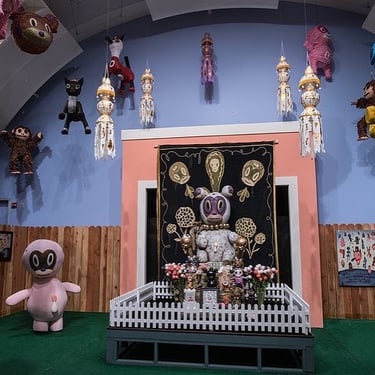
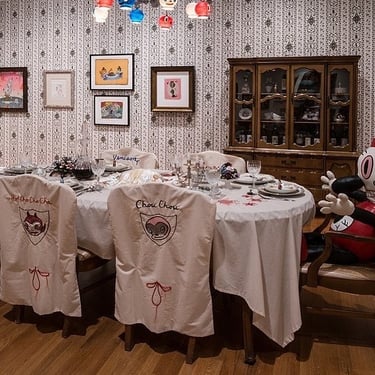

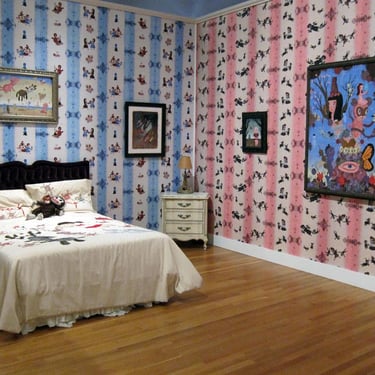

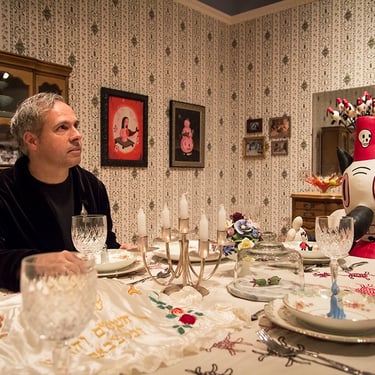
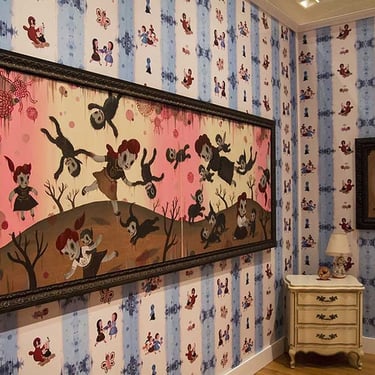
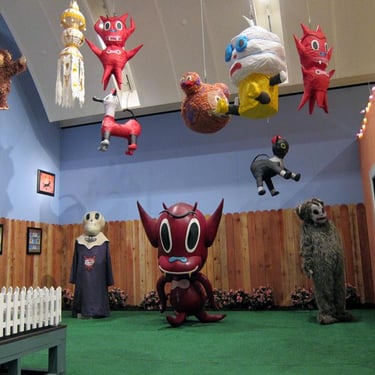
We didn’t lose our inner child. We turned it into Art.
You collecting, or just hoarding what the algorithm spoon-feeds you?
contact
© 2025. All rights reserved.


